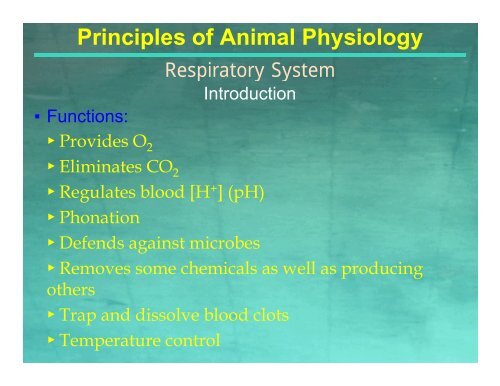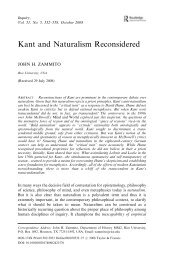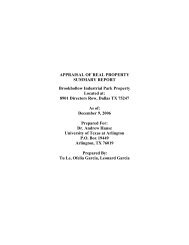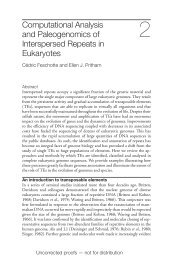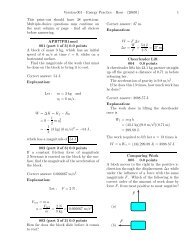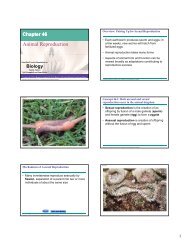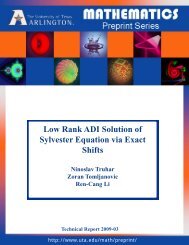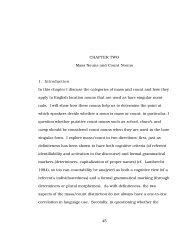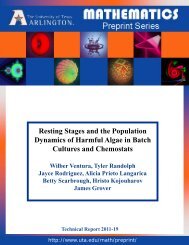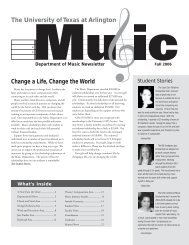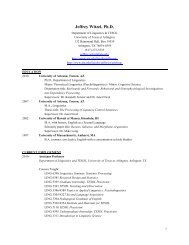Principles of Animal Physiology
Principles of Animal Physiology
Principles of Animal Physiology
Create successful ePaper yourself
Turn your PDF publications into a flip-book with our unique Google optimized e-Paper software.
<strong>Principles</strong> <strong>of</strong> <strong>Animal</strong> <strong>Physiology</strong><br />
▪ Functions:<br />
▸ Provides O2 Respiratory System<br />
Introduction<br />
▸ Eliminates CO 2<br />
▸ Regulates blood [H + ] (pH)<br />
▸ Phonation<br />
▸ Defends against microbes<br />
▸ Remo Removes es some chemicals as well as producing<br />
others<br />
▸ Trap and dissolve blood clots<br />
▸ Temperature control
<strong>Principles</strong> <strong>of</strong> <strong>Animal</strong> <strong>Physiology</strong><br />
▪ Atmospheric pressure<br />
Respiratory System<br />
Introduction
<strong>Principles</strong> <strong>of</strong> <strong>Animal</strong> <strong>Physiology</strong><br />
▪ Composition <strong>of</strong> air<br />
Respiratory System<br />
Introduction
<strong>Principles</strong> <strong>of</strong> <strong>Animal</strong> <strong>Physiology</strong><br />
Respiratory System<br />
Introduction<br />
▪ Diversity <strong>of</strong> gas exchange structures
<strong>Principles</strong> <strong>of</strong> <strong>Animal</strong> <strong>Physiology</strong><br />
Respiratory System<br />
External & Internal Respiraton<br />
▪ External respiration can<br />
involve four major steps:<br />
▸ External bulk transport<br />
▸ Respiratory surface<br />
diffusion<br />
▸ Circulation<br />
▸ Tissue diffusion
<strong>Principles</strong> <strong>of</strong> <strong>Animal</strong> <strong>Physiology</strong><br />
Respiratory System<br />
Water Breathers<br />
▪ It is more difficult to exchange gases in water<br />
▸ O 2 relatively insoluble in water, 10k slower<br />
▸ CO CO2 is 20 times more soluble in water than O O2 ▸ Their solubility decreases with increasing salinity<br />
▸ Th Their i soulbility lbilit decreases d with ith iincreasing i<br />
temperature<br />
▸ O O2 content in water varies more than in air<br />
▸ Unlike air, water has other life-sustaining<br />
components other than gases, gases like dissolved ions, ions<br />
organic matter and water
<strong>Principles</strong> <strong>of</strong> <strong>Animal</strong> <strong>Physiology</strong><br />
Respiratory System<br />
Introduction<br />
▪ Respiration in gill-breathing fish
<strong>Principles</strong> <strong>of</strong> <strong>Animal</strong> <strong>Physiology</strong><br />
Respiratory System<br />
▪ Nonrespiratory functions <strong>of</strong> aquatic respirers<br />
▸ Fluid and solute balance<br />
♦ Regulate osmotic and ionic gradients<br />
▸ Acid-base balance<br />
♦ Removal <strong>of</strong> H + and HCO 3-<br />
▸ Excretion<br />
♦ Removal <strong>of</strong> ammonia<br />
▸ NNutrient i and d mineral i l uptake k<br />
♦ Intake <strong>of</strong> NaCl and Ca2+ ▸ FFeeding di<br />
♦ Ciliated gills trap plankton<br />
▸ T t l ti
<strong>Principles</strong> <strong>of</strong> <strong>Animal</strong> <strong>Physiology</strong><br />
Respiratory System<br />
Air Respirers<br />
▪ Transition from water to land had its<br />
challenges<br />
▪ Air has much more oxygen yg than water<br />
▪ Air is less viscous than water<br />
▪ It takes less energy to pump air<br />
▪ However, respiratory surfaces must be kept<br />
moist i t for f proper diffusion<br />
diff i
<strong>Principles</strong> <strong>of</strong> <strong>Animal</strong> <strong>Physiology</strong><br />
Respiratory System<br />
Air Respirers<br />
▪ Since respiratory surfaces must be kept moist<br />
for proper diffusion<br />
▸ Land animals must remain in moist conditions<br />
▸ Land animals must have covered or fully internal<br />
structures for gas exchange<br />
♦ Internal air tubes - tracheae (insects)<br />
♦ Gill-like book lungs (scorpions)<br />
♦ MMantle tl cavities iti (snails) ( il )<br />
♦ Vascularized sacs - lungs (snails & land vertebrates)
<strong>Principles</strong> <strong>of</strong> <strong>Animal</strong> <strong>Physiology</strong><br />
▪ Book lung <strong>of</strong> a<br />
Spider<br />
▸ Modified gill?<br />
Respiratory System<br />
Air Respirers
<strong>Principles</strong> <strong>of</strong> <strong>Animal</strong> <strong>Physiology</strong><br />
▪ Bimodal breathers<br />
Respiratory System<br />
Air Respirers<br />
▸ Have gills & another respiratory surface<br />
♦ Integumentary exchange<br />
♦ Modified gills<br />
♦ Digestive system<br />
♦ Air sacs (lungs)
<strong>Principles</strong> <strong>of</strong> <strong>Animal</strong> <strong>Physiology</strong><br />
Respiratory System<br />
Air Respirers<br />
▪ Bimodal breather - Frogs g<br />
▸ From eggs, laval stages have gills<br />
♦ Uses lungs g & skin to breathe<br />
♦ Uses buccal pump to force air into lungs (like fish)<br />
♦ Several inspiratory oscillation needed to fill lungs<br />
♦ One long exhalation empties lungs<br />
♦ O2 intake mainly through lungs<br />
♦ CO CO2 elimination i i i through cutaneous
<strong>Principles</strong> <strong>of</strong> <strong>Animal</strong> <strong>Physiology</strong><br />
Respiratory System<br />
Air Respirers<br />
▪ Bimodal breather - Frogs g - Fig g 11-11<br />
▸ Open nostrils<br />
▸ Lower floor <strong>of</strong> buccal cavity<br />
▸ Air rushes into buccal cavity<br />
▸ Close nostrils<br />
▸ Elevate floor <strong>of</strong> buccal cavity<br />
▸ Open glottis<br />
▸ Pump air into lungs<br />
▸ Close glottis<br />
▸ Repeat to inflate lungs<br />
K l tti d th t h l
<strong>Principles</strong> <strong>of</strong> <strong>Animal</strong> <strong>Physiology</strong><br />
Respiratory System<br />
Air Respirers<br />
▪ Comparative lung structure <strong>of</strong> amphibians,<br />
reptiles, and mammals<br />
▪ Fig g<br />
11-10
<strong>Principles</strong> <strong>of</strong> <strong>Animal</strong> <strong>Physiology</strong><br />
▪ Avian respiration<br />
▸ Lungs are inelastic<br />
▸ Several air sacs<br />
Respiratory System<br />
Air Respirers<br />
▸ Unidirectional or flow-through<br />
▸ Membranous diaphragm
<strong>Principles</strong> <strong>of</strong> <strong>Animal</strong> <strong>Physiology</strong><br />
Respiratory System<br />
Air Respirers<br />
▪ Avian respiration - Gas exchange surface<br />
▸ Capillaries smaller than mammals: 3-10µm vs 35µm<br />
in mammals<br />
▸ Air capillaries are not blind-ending, but<br />
communicate with each other<br />
▸ Diameter <strong>of</strong> air capillaries do not change during the<br />
respiratory p ycycle y<br />
▸ Surfactant’s role is limited to restricting fluid<br />
movement from blood to air capillaries<br />
▸ Mean thickness <strong>of</strong> the blood-gas barrier is less in<br />
birds
<strong>Principles</strong> <strong>of</strong> <strong>Animal</strong> <strong>Physiology</strong><br />
▪ Respiration in birds<br />
▪ Fig 11-16<br />
Respiratory System<br />
Air Respirers
<strong>Principles</strong> <strong>of</strong> <strong>Animal</strong> <strong>Physiology</strong><br />
Respiratory System<br />
Air Breathers<br />
▪ Movement <strong>of</strong> pure O 2 (shaded) through the<br />
avian lung<br />
▪ Fig g<br />
11-16, Part II
<strong>Principles</strong> <strong>of</strong> <strong>Animal</strong> <strong>Physiology</strong><br />
Respiratory System<br />
Air Respirers<br />
▪ Nonrespiratory functions <strong>of</strong> the avian<br />
respiratory system<br />
▸ Regulation <strong>of</strong> water loss and heat exchange<br />
▸ Circulation - enhances venous return<br />
▸ Acid Acid-base base balance<br />
▸ Vocalization, mating calls and other sounds<br />
▸ Defense<br />
▸ Removal, modification, activation, or inactivation<br />
<strong>of</strong> various materials<br />
▸ Olfaction
<strong>Principles</strong> <strong>of</strong> <strong>Animal</strong> <strong>Physiology</strong><br />
Respiratory System<br />
Air Respirers<br />
▪ Anatomy <strong>of</strong> the respiratory system in a<br />
mammal<br />
▪ Fig 11 11-12<br />
12
<strong>Principles</strong> <strong>of</strong> <strong>Animal</strong> <strong>Physiology</strong><br />
Respiratory System<br />
Air Respirers<br />
▪ Mammalian respiratory pathway
<strong>Principles</strong> <strong>of</strong> <strong>Animal</strong> <strong>Physiology</strong><br />
Respiratory System<br />
Air Respirers<br />
▪ Ciliated respiratory epithelium cells
<strong>Principles</strong> <strong>of</strong> <strong>Animal</strong> <strong>Physiology</strong><br />
Respiratory System<br />
Air Respirers<br />
▪ Diagram representing the human airways
<strong>Principles</strong> <strong>of</strong> <strong>Animal</strong> <strong>Physiology</strong><br />
Respiratory System<br />
Air Respirers<br />
▪ Respiratory zone structures
<strong>Principles</strong> <strong>of</strong> <strong>Animal</strong> <strong>Physiology</strong><br />
Respiratory System<br />
Air Respirers<br />
▪ Alveolus and associated pulmonary capillaries<br />
▪ Alveolar epithelial cells<br />
▸ Type I: flattened processes which cover most <strong>of</strong> the<br />
inner surface<br />
▸ Type II: produce and store surfactant<br />
▸ Macropharges: phagocytic cells<br />
▸ pores <strong>of</strong> Kohn permit airflow between adjacent<br />
▸ pores <strong>of</strong> Kohn - permit airflow between adjacent<br />
alveoli, a process known as collateral ventilation
<strong>Principles</strong> <strong>of</strong> <strong>Animal</strong> <strong>Physiology</strong><br />
Respiratory System<br />
Air Respirers<br />
▪ Alveolus and associated pulmonary capillaries<br />
▪ Fig 11-13
<strong>Principles</strong> <strong>of</strong> <strong>Animal</strong> <strong>Physiology</strong><br />
▪ Pleural sac<br />
▪ Fig 11-14<br />
Respiratory System<br />
Air Respirers
<strong>Principles</strong> <strong>of</strong> <strong>Animal</strong> <strong>Physiology</strong><br />
Respiratory System<br />
Respiratory Mechanics<br />
▪ Pressures associated with breathing<br />
▸ Atmospheric (barometric) pressure<br />
♦ At sealevel = 760mm Hg (1atm or 101.3 kPa)<br />
▸ Intrapulmonary (intra-alveolar) pressure<br />
♦ May be less ess tthan, a , equal equa to oor ggreater eate tthan a at atmospheric osp e c<br />
pressure<br />
▸ Intrapleural (intrathoracic) pressure<br />
♦ Always less than atmospheric pressure, except during<br />
maximal, forced expiration<br />
▸ TTransmural l pressure<br />
♦ Pressure difference between alveolus and pleural cavity<br />
♦ Pressure difference betwen atmostphere and pleural
<strong>Principles</strong> <strong>of</strong> <strong>Animal</strong> <strong>Physiology</strong><br />
Respiratory System<br />
Respiratory Mechanics<br />
▪ Pressures important to ventilation <strong>of</strong> a<br />
mammalian lung
<strong>Principles</strong> <strong>of</strong> <strong>Animal</strong> <strong>Physiology</strong><br />
Respiratory System<br />
Respiratory Mechanics<br />
▪ Transmural pressure gradient in a mammalian<br />
lung
<strong>Principles</strong> <strong>of</strong> <strong>Animal</strong> <strong>Physiology</strong><br />
▪ Boyle’s Boyle s law<br />
Respiratory System<br />
Respiratory Mechanics
<strong>Principles</strong> <strong>of</strong> <strong>Animal</strong> <strong>Physiology</strong><br />
Respiratory System<br />
Respiratory Mechanics<br />
▪ Anatomy <strong>of</strong> the respiratory muscles in<br />
mammal
<strong>Principles</strong> <strong>of</strong> <strong>Animal</strong> <strong>Physiology</strong><br />
Respiratory System<br />
Respiratory Mechanics<br />
▪ Respiratory p y muscle activity y during g inspiration p<br />
in humans
<strong>Principles</strong> <strong>of</strong> <strong>Animal</strong> <strong>Physiology</strong><br />
Respiratory System<br />
Respiratory Mechanics<br />
▪ Respiratory p y muscle activity y during g expiration p in<br />
humans
<strong>Principles</strong> <strong>of</strong> <strong>Animal</strong> <strong>Physiology</strong><br />
Respiratory System<br />
Respiratory Mechanics<br />
▪ Pressures changes during breathing
<strong>Principles</strong> <strong>of</strong> <strong>Animal</strong> <strong>Physiology</strong><br />
Respiratory System<br />
Respiratory Mechanics<br />
▪ Pressures associated with breathing
<strong>Principles</strong> <strong>of</strong> <strong>Animal</strong> <strong>Physiology</strong><br />
Respiratory System<br />
Respiratory Mechanics<br />
▪ Sufactant and Law <strong>of</strong> LaPlace
<strong>Principles</strong> <strong>of</strong> <strong>Animal</strong> <strong>Physiology</strong><br />
Respiratory System<br />
Respiratory Mechanics<br />
▪ Lung volumes & Spirometry
<strong>Principles</strong> <strong>of</strong> <strong>Animal</strong> <strong>Physiology</strong><br />
Respiratory System<br />
Respiratory Mechanics<br />
▪ Variations in lung volume
<strong>Principles</strong> <strong>of</strong> <strong>Animal</strong> <strong>Physiology</strong><br />
Respiratory System<br />
Respiratory Mechanics<br />
▪ Dead Space - regions where there is not gas<br />
exchange<br />
▸ - Anatomical Dead Space (ADS)<br />
♦ Man - 0.15 L<br />
♦ Giraffe - 1.7 L<br />
♦ Horse - 1.8 L<br />
▸ - Alveolar Dead Space p
<strong>Principles</strong> <strong>of</strong> <strong>Animal</strong> <strong>Physiology</strong><br />
▪ Pulmonary Ventilation<br />
Respiratory System<br />
Respiratory Mechanics<br />
▸ Total pulmonary ventilation = minute ventilation =<br />
minute respiratory p yvolume<br />
▸ Minute ventilation = Tidal volume x respiratory<br />
frequency q y<br />
▸ If VE = 500 ml, f = 12 breaths/min, then VE (V dot E,<br />
minute ventilation) ) = 6000 ml/min<br />
▸ Alveoli ventilation = amount fresh air reaching<br />
alveoli per minute<br />
▸ VA (V dot A) = (VE -VD) x f , if VD = 150 ml then,<br />
▸ V dot A = (500 - 150) x f = 350 x 12 = 4200 ml/min
<strong>Principles</strong> <strong>of</strong> <strong>Animal</strong> <strong>Physiology</strong><br />
Respiratory System<br />
Gas Transport<br />
▪ O 2 and CO 2 levels in the respiratory system <strong>of</strong><br />
mammals
<strong>Principles</strong> <strong>of</strong> <strong>Animal</strong> <strong>Physiology</strong><br />
Respiratory System<br />
Gas Transport<br />
▪ Most O 2 in animals is carried bound to<br />
respiratory pigments<br />
▸ O 2 carried in blood in two forms<br />
♦ Physically dissolved<br />
♦ Chemically y bound<br />
– Hemoglobin (Hb), most common<br />
– Hemocyanin - crustaceans & mullusks<br />
Hemerythrin some worms<br />
– Hemerythrin - some worms<br />
♦ Most insects do not need respiratory pigments
<strong>Principles</strong> <strong>of</strong> <strong>Animal</strong> <strong>Physiology</strong><br />
Respiratory System<br />
Gas Transport<br />
▪ Hemoglobin molecule from a mammal
<strong>Principles</strong> <strong>of</strong> <strong>Animal</strong> <strong>Physiology</strong><br />
Respiratory System<br />
Gas Transport<br />
▪ Oxygen-hemoglobin Oxygen hemoglobin dissociation curves
<strong>Principles</strong> <strong>of</strong> <strong>Animal</strong> <strong>Physiology</strong><br />
Respiratory System<br />
Gas Transport<br />
▪ Factors that affect the O 2-Hb 2 Hb curve
<strong>Principles</strong> <strong>of</strong> <strong>Animal</strong> <strong>Physiology</strong><br />
Respiratory System<br />
Gas Transport<br />
▪ Effects on the O O2-Hb 2 Hb dissociation curve<br />
▸ Amount <strong>of</strong> O2 combined with Hb varies with major<br />
factors accompanying p y g tissue metabolism, , eg: g<br />
♦ Acidity: Bohr effect:- ↑PCO2 & [H + ] → shift to the right<br />
♦ Temperature: ↑temp → shift to the right<br />
♦ Organic Phosphates<br />
– 2-3-diphosphoglycerate: Affinity <strong>of</strong> Hb to O2 decreased in its<br />
presence presence. Acute or chronic exposure to low PO 2 → ↑2-3-D ↑2 3 D.P.G. PG →<br />
shift to the right (in mammals)<br />
– Inositol pentaphosphate (IPP) in birds<br />
– Nuleoside triphosphates (NTPs) in fishes<br />
– Adenosine triphosphate (ATP) in salmonoids, sharks and rays<br />
– Guanosine triphosphate (GTP) in eels, carp, goldfish
<strong>Principles</strong> <strong>of</strong> <strong>Animal</strong> <strong>Physiology</strong><br />
▪ Bohr and root effects<br />
Respiratory System<br />
Gas Transport
<strong>Principles</strong> <strong>of</strong> <strong>Animal</strong> <strong>Physiology</strong><br />
Respiratory System<br />
Gas Transport<br />
▪ Carbon dioxide transport in blood
<strong>Principles</strong> <strong>of</strong> <strong>Animal</strong> <strong>Physiology</strong><br />
Respiratory System<br />
Gas Transport<br />
▪ Abnormal blood-gas blood gas levels<br />
▸ Arterial O 2 abnomalities<br />
♦ Hypoxic hypoxia<br />
– Low arterial blood O 2 - inadequate Hb & blood saturation<br />
♦ Anemic hypoxia<br />
– Reduced O 2-carrying capacity<br />
♦ Circulating hypoxia<br />
– Too little oxygenated blood delivered to tissues<br />
♦ Histoxic hypoxia<br />
–O 2 delivery normal, but cells cannot use the O 2 delivered to them
<strong>Principles</strong> <strong>of</strong> <strong>Animal</strong> <strong>Physiology</strong><br />
Respiratory System<br />
Gas Transport<br />
▪ Abnormal blood-gas blood gas levels<br />
▸ Arterial CO 2 abnomalities<br />
♦ Hypercapnia<br />
– Excessive CO2 in arterial blood, caused by hypoventilation -<br />
underbreathing<br />
♦ HHypocapnia i<br />
– Below normal arterial CO 2 levels, caused by hyperventilation -<br />
overbreating
<strong>Principles</strong> <strong>of</strong> <strong>Animal</strong> <strong>Physiology</strong><br />
▪ Effects <strong>of</strong><br />
hyperventilation and<br />
hypoventilation yp<br />
on blood<br />
gasses<br />
Respiratory System<br />
Gas Transport
<strong>Principles</strong> <strong>of</strong> <strong>Animal</strong> <strong>Physiology</strong><br />
Respiratory System<br />
Control <strong>of</strong> Respiration<br />
▪ Peripheral chemoreceptors<br />
▸ pH<br />
▸ PCO 2<br />
▸ PO 2
<strong>Principles</strong> <strong>of</strong> <strong>Animal</strong> <strong>Physiology</strong><br />
Respiratory System<br />
Control <strong>of</strong> Respiration<br />
▪ Central Chemoreceptors<br />
▸ Mediate response by changes in PCO 2 and H +<br />
▸ Arterial PCO 2 crosses BBB → CSF PCO 2<br />
▸ In CSF: CO2 + H2O → H + + HCO -<br />
3<br />
▸ H + ▸ H causes ↑ ventilation<br />
* H + ▸ * H d tdiff BBB<br />
+ do not diffuse across BBB
<strong>Principles</strong> <strong>of</strong> <strong>Animal</strong> <strong>Physiology</strong><br />
Respiratory System<br />
Control <strong>of</strong> Respiration<br />
▪ Respiratory control centers in the brainstem
<strong>Principles</strong> <strong>of</strong> <strong>Animal</strong> <strong>Physiology</strong><br />
Respiratory System<br />
Control <strong>of</strong> Respiration<br />
▪ Neural and chemical influences
<strong>Principles</strong> <strong>of</strong> <strong>Animal</strong> <strong>Physiology</strong><br />
▪ Stop here<br />
▪ RReview i<br />
Respiratory System


